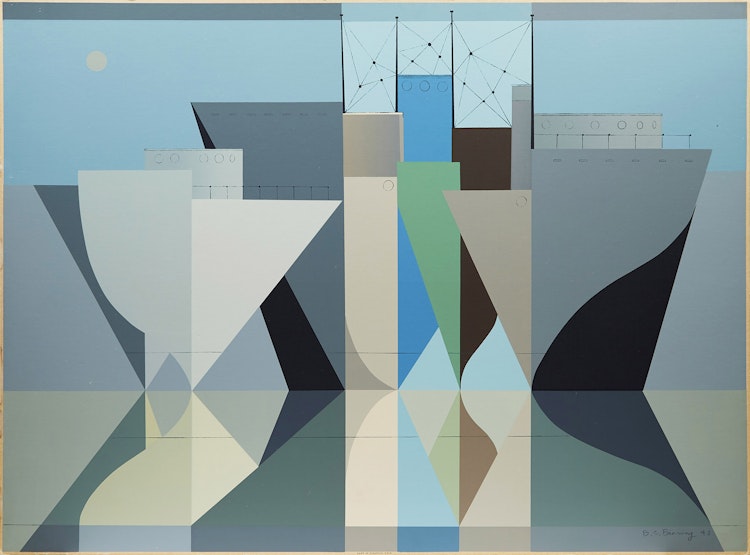Ships in Classical Calm by Bertram Charles Binning

B.C. Binning
Ships in Classical Calm
silkscreen
Sampson Matthews; unframed
30 x 40 ins ( 76.2 x 101.6 cms ) ( sheet )
Auction Estimate: $700.00 - $900.00
Price Realized $1,180.00
Sale date: February 18th 2020
Private Collection, Alberta
Share this item with your friends
Bertram Charles Binning
(1909 - 1976) Canadian Group of Painters
Bertram Charles Binning (born 10 February 1909 in Medicine Hat, Alberta; died 16 March 1976 in Vancouver, British Columbia), popularly known as B. C. Binning, was a leading Canadian artist.
As a boy he spent much of his time visiting his grandfather’s architectural offices and when he moved to the West Coast he was on the water much of the time, boating and fishing; both pastimes were to influence his as an artist. Illness prevented him from becoming an architect but in the following years he studied at the Vancouver School of Art; University of Oregon; Art Students’ League, New York, under Yasuo Kumyoshi; and in London, England at the Central School of Art and the Westminster School of Art; also under Henry Moore; in New York under Amédée Ozenfant.
On his return to Canada he taught at the Vancouver School of Art 1939-49 and he developed his fine calligraphic pen drawings. About 1949 he began his semi-abstract easel paintings. These works although completely different in style were still of boats, sea, sun, and coastal elements. His canvas “Ships in a Classical Calm” has been written about and in many books on Canadian art and was exhibited at the 1954 Venice Biennale.
In Binning's personal artistic practice he revealed his lifestyle. Known as an excellent draughtsman, he recorded his experiences in intricate line drawings: a detailed remembrance of an unusual hotel room, studies of peaceful-looking female figures, or an architectural drawing of a street in Vancouver. The drawings exude humour and love: a friend cutting a dog's hair, a picnic view from a high perch, self-portraits of self-portraits. Innovative and intelligent, his hospitality to students, colleagues and world figures alike made him a well-loved professor.
The paintings, internationally recognized and exhibited regularly, are composed and formal yet saturated with his leisurely weekends sailing the B.C. Coast with Jessie. The nautical themes and the layered, regal, simple, ship forms portray a unique architectural style. The celebratory touches are often primary colours. The expanses of painted shapes are purely those of the coast he knew best.
In architecture, he is regarded as a colour expert. One of his first articles on this subject appeared in “Canadian Art” magazine in 1954 with a photograph of his colour scheme implemented in a B.C. Electric Co. power sub-station. He also wrote for this magazine on the problems of an artist when working with mosaics using for illustrations for his own mosaics in Vancouver which he did for Radio CKWX Studios; British Columbia Power Corporation, and his 44 foot mosaic at the Imperial Bank Building. His murals have been largely abstract geometrical patterns contained within squares and rectangles and have decorated several offices in Vancouver. In his home which he designed himself, he had done one of these murals, and a long hallway served as a gallery for his easel paintings.
Binning's monumental accomplishments on the scene of Vancouver's art and architecture placed the city on the cultural map internationally. In 1946 he helped to found the Art in Living Group, which in 1949 had a major show, Design for Living, at the Vancouver Art Gallery. His visits to Japan and collaborative personality made him an important figure in the negotiations for the Nitobe Garden at U.B.C. He founded and presided over the U.B.C. Festival of the Contemporary Arts, a mold-breaking yearly avant-garde celebration spanning the decade of the 1960s in Vancouver, at the peak of which Marshall McLuhan spoke in 1964.
Eventually he helped found the Department of Fine Art at U.B.C. and headed it. He presented many papers internationally; was on advisory boards; received innumerable grants, awards, fellowships, one-man shows and retrospective exhibitions. He became an Officer of the Order of Canada in 1971. He retired in 1974.
In 1997, the Bauhaus-influenced home Binning designed for himself in 1941 in West Vancouver was declared a National Historic Site of Canada. His beloved Jessie, surviving him by 3 decades, had lived and managed his legacy there until then. His work continues to be shown regularly in Metro Vancouver - lately at the Vancouver Art Gallery, Burnaby Art Gallery and West Vancouver Museum; and is part of The Artists4Kids Trust..

